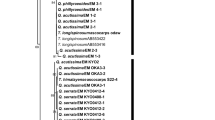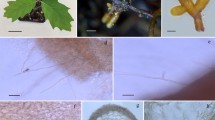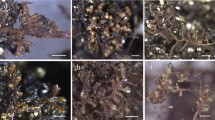Abstract
We aimed to test whether Tuber melanosporum and native Chinese oak species could form stable mycorrhizal symbioses. Six oak species were all either inoculated or not, with spores of the Périgord black truffle in the greenhouse. Ectomycorrhizal development was monitored for up to 32 months. Seedling growth was assessed 2 years after inoculation. From 6 months after inoculation, Tuber melanosporum ectomycorrhizae were successfully produced on five Quercus species endemic to China, as shown by morphological, anatomical, and molecular analyses. Quercus mongolica and Q. longispica showed high receptivity to mycorrhization by T. melanosporum. The symbioses obtained with these two species and with Quercus senescens were stable for at least 32 months. Averaged over all three oak species, mycorrhization by T. melanosporum significantly enhanced canopy diameter, number of leaves, and mean leaf dimension. In spring 2019, mycorrhization by T. melanosporum accelerated budbreak in Q. mongolica. Quercus fabrei and Q. variabilis formed ectomycorrhizae up to 9 months after inoculation but seedlings died 3 months later, probably because of damage by grazing insects. Quercus pseudosemecarpifolia failed to form ectomycorrhizae. Results suggest that T. melanosporum–mycorrhized Q. mongolica and Q. longispica seedlings could be tested for ascocarp production and increased performance in the field.



Similar content being viewed by others
References
Agerer R (2006) Fungal relationships and structural identity of their ectomycorrhizae. Mycol. Prog. 5:67–107
Álvarez-Lafuente A, Benito-Matías LF, Peñuelas-Rubira JL, Suz LM (2018) Multi-cropping edible truffles and sweet chestnuts: production of high-quality Castanea sativa seedlings inoculated with Tuber aestivum, its ecotype T. uncinatum, T. brumale, and T. macrosporum. Mycorrhiza 28:29–38. https://doi.org/10.1007/s00572-017-0805-9
Bencivenga M, Venanzi G (1990) Alcune osservazioni sull’accrescimento delle piante tartufigene in pieno campo. In: Bencivenga M, Granetti B (eds) Atti del, II., Congr, Int., Sul, Tartufo, Comunita´ Montana dei Monti Martani e del Serano, Spoleto, pp 241–248
Benucci GMN, Bonito G, Falini LB, Bencivenga M, Donnini D (2012) Truffles, timber, food, and fuel: sustainable approaches for multi-cropping truffles and economically important plants. In: Zambonelli A, Bonito GM (eds) Edible ectomycorrhizal mushrooms. Soil Biology 34, Springer-Verlag Berlin, Heidelberg, pp 265–280. https://doi.org/10.1007/978-3-642-33823-6_15
Bonet JA, Fischer CR, Colinas C (2006) Cultivation of black truffle to promote reforestation and land-use stability. Agronomy for Sustainable Development 26:69–76
Bonito G, Trappe JM, Donovan S, Vilgalys R (2011) The Asian black truffle Tuber indicum can form ectomycorrhizas with North American host plants and complete its life cycle in non-native soils. Fungal Ecology 4:83–93. https://doi.org/10.1016/j.funeco.2010.08.003
Chen J (2007) Taxonomy and phylogeny of the genus Tuber in China (Pezizales, Ascomycetes, Ascomycota). Ph.D. Thesis, Kunming Institute of Botany, Chinese Academy of Sciences, China. In Chinese, with English abstract.
Chen J, Guo SX, Liu PG (2011) Species recognition and cryptic species in the Tuber indicum complex. PLoS ONE 6(1):e14625. https://doi.org/10.1371/journal.pone.0014625
Chen YL (2002) Mycorrhizal formation of Tuber melanosporum. Edible fungi of China 21:15-17. In Chinese, with English abstract.
Chevalier G, Grente J (1978) Application pratique de la symbiose ectomycorhizienne: production à grande échelle de plants mycorhizés par la truffe (Tuber melanosporum Vitt.). [Practical application of ectomycorrhizal symbiosis : large-scale production of seedlings mycorrhized by the truffle (Tuber melanosporum Vitt.).]. Mushroom Science X (Part II), Proceedings of the Tenth International Congress on the Science and Cultivation of Edible Fungi, France, 1978. Pp. 483-505. In French with English and German summaries.
Cloyd RA (2015) Ecology of fungus gnats (Bradysia spp.) in greenhouse production systems associated with disease-interactions and alternative management strategies. Insects 6:325–332
Culleré L, Ferreira V, Venturini ME, Marco P, Blanco D (2013) Potential aromatic compounds as markers to differentiate between Tuber melanosporum and Tuber indicum truffles. Food Chemistry 141:105–110
Culleré L, Ferreira V, Marco P, Venturini ME, Blanco D (2017) Does the host tree exert any influence on the aromatic composition of the black truffle (Tuber melanosporum)? Flavour and Fragrance Journal 32:134–140
Del Lungo A, Ball J, Carle J (2006) Global planted forests thematic study. Results and analysis. Planted Forests & Trees Working Paper FP38E, FAO (ed).
Domínguez-Nuñez JA, Medina M, Berrocal-Lobo M, Anriquez A, Albanesi A (2015) The combined effects of Pseudomonas fluorescens CECT 844 and the black truffle coinoculation on Pinus nigra seedlings. iForest 8:624-630.
Domínguez JA, Martin A, Anriquez A, Albanesi A (2012) The combined effects of Pseudomonas fluorescens and Tuber melanosporum on the quality of Pinus halepensis seedlings. Mycorrhiza 22:429–436. https://doi.org/10.1007/s00572-011-0420-0
Domínguez JA, Planelles R, Rodríguez Barreal JA, Saiz de Omeñaca JA (2008) The effect of Tuber melanosporum Vitt. mycorrhization on growth, nutrition, and water relations of Quercus petraea Liebl., Quercus faginea Lamk., and Pinus halepensis Mill. seedlings. New Forests 35:159–171. https://doi.org/10.1007/s11056-007-9069-0
Domínguez JA, Selva J, Rodríguez Barreal JA, Saiz de Omeñaca JA (2006) The influence of mycorrhization with Tuber melanosporum in the afforestation of a Mediterranean site with Quercus ilex and Quercus faginea. Forest Ecology and Management 231:226–233. https://doi.org/10.1016/j.foreco.2006.05.052
Donnini D, Gargano ML, Perini C, Savino E, Murat C, Di Piazza S, Altobelli E, Salerni E, Rubini A, Rana GL, Bencivenga M, Venanzoni R, Zambonelli A (2013) Wild and cultivated mushrooms as a model of sustainable development. Plant Biosystems-An Int J Dealing Aspects of Plant Biol 147:226–236
Editorial committee of the Flora of China of Chinese Academy of Sciences (1990). Flora of China, Beijing, Beijing Science Press, Volume 22. In Chinese
Fassi B, Fontana A (1967) Sintesi micorrizica tra Pinus strobus e Tuber maculatum - I. Micorrize e sviluppo dei semenzali nel secondo anno. Allionia 13:177–186 In Italian
García-Montero LG, Casermeiro MÁ, Manjón JL, Hernando I (2007) Impact of active soil carbonate and burn size on the capacity of the rockrose Cistus laurifolius, to produce Tuber melanosporum carpophores in truffle culture. Mycological Research 111:734–739
Gardes M, Bruns TD (1993) ITS primers with enhanced specificity for basidiomycetes application to the identification of mycorrhizae and rusts. Mol Ecol. 2:113–118
Giovannetti G, Fontana A (1982) Mycorrhizal synthesis between Cistaceae and Tuberaceae. New Phytol 92:533–537
Giraud M (1988) Prélèvement et analyse de mycorhizes. [Sampling and analysis of mycorrhizae]. In: Centre Technique Interprofessionnel des Fruits et Légumes CTIFL (ed) La Truffe 10:49–63 In French
Guerin-Laguette A, Cummings N, Hesom-Williams N, Butler R, Wang Y (2013) Mycorrhiza analyses in New Zealand truffières reveal frequent but variable persistence of Tuber melanosporum in co-existence with other truffle species. Mycorrhiza 23:87–98
He F, Yang B, Wang H, Yan Q, Cao Y, He X (2016) Changes in composition and diversity of fungal communities along Quercus mongolica forests developments in Northeast China. Applied Soil Ecology 100:162–171
Hu HT, Wang Y, Hu BY (2005) Cultivation of Tuber formosanum on limed soil in Taiwan. New Zeal J Crop Hort 33:363–366
Hurlbert SH (1984) Pseudoreplication and the design of ecological field experiments. Ecological Monographs 54:187–211
Jia SM, Chen QZ, Liu GJ, Wang RX (2018) A review of the value of historical materials concerning fungi cultivation in science journals in late Qing Dynasty. Edible and medicinal mushrooms 26:325–329 In Chinese
Jin ZZ, Qu PD (1981) Sclerophyllous evergreen broad-leaf trees in China. Journal of Yunnan University (Natural Sciences) 2:13–20 In Chinese
Kennedy P (2010) Ectomycorrhizal fungi and interspecific competition: species interactions, community structure, coexistence mechanisms, and future research directions. New Phytol. 187:895–910
Lei JP, Xiao WF, Liu JF (2013) Distribution of Quercus variabilis Blume and Its Ecological Research in China. World Forestry Research 26:57-62. In Chinese, with English abstract.
Lin Q, Ran XX, Zhao J, Liu YX, Liu CY, Han D (2013) A study of techniques of cultivating and detecting ectomycorrhizal seedlings of Black Truffle (Tuber melanosporum) and Summer Truffle (Tuber aestivum). Journal of Sichuan Forestry Science and Technology 34:41–43. In Chinese, with English abstract.
Liu PG, Wang Y, Wang XH, Chen J, Zheng HD, Deng XJ, Qiao P, Jiang H, Tian XF, Zhang JP, Wan SP, Wang R (2011) Outline of Chinese truffles and their conservational strategies. Journal of Fungal Research 9:232-243. In Chinese, with English abstract.
Ma CL (2006) Phylogeny and biogeography of Quercus Sect. Heterobalanus (Fagaceae). Ph.D. Thesis, Kunming Institute of Botany, Chinese Academy of Sciences, China. In Chinese, with English abstract
McCullagh P, Nelder JA (1989) Generalized Linear Models. Chapman & Hall, London, pp 511+xix.
Mao LG, Yan DD, Wu ZF, Ma TT, Wang QX, Li Y, Guo MX, Ouyang CB, Cao AC, Zheng JQ (2013) Research progress in seed treatment. China Vegetables 10:9-15. In Chinese, with English abstract.
Marozzi G, Sánchez S, Benucci GMN, Bonito G, Falini LB, Albertini E, Donnini D (2017) Mycorrhization of pecan (Carya illinoinensis) with black truffles: Tuber melanosporum and Tuber brumale. Mycorrhiza 27:303–309
Martin F, Kohler A, Murat C, Balestrini R, Coutinho PM, Jaillon O, Montanini B, Morin E, Noel B, Percudani R, Porcel B, Rubini A, Amicucci A, Amselem J, Anthouard V, Arcioni S, Artiguenave F, Aury JM, Ballario P, Bolchi A, Brenna A, Brun A, Buée M, Cantarel B, Chevalier G, Couloux A, da Silva C, Denoeud F, Duplessis S, Ghignone S, Hilselberger B, Iotti M, Marçais B, Mello A, Miranda M, Pacioni G, Quesneville H, Riccioni C, Ruotolo R, Splivallo R, Stocchi V, Tisserant E, Viscomi AR, Zambonelli A, Zampieri E, Henrissat B, Lebrun MH, Paolocci F, Bonfante P, Ottonello S, Wincker P (2010) Périgord black truffle genome uncovers evolutionary origins and mechanisms of symbiosis. Nature 464:1033–1038. https://doi.org/10.1038/nature08867
Martin-Santafe M, Perez-Fortea V, Zuriaga P, Barriuso J (2014) Phytosanitary problems detected in truffle cultivation in Spain. A review. Forest Systems 23:307–316
Mello A, Murat C, Bonfante P (2006) Truffles: much more than a prized and local fungal delicacy. FEMS Microbiology Letters 260:1–8
Meng HH, Su T, Gao XY, Li J, Jiang XL, Sun H, Zhou ZK (2017) Warm-cold colonization: response of oaks to uplift of the Himalaya-Hengduan Mountains. Molecular Ecology 26:3276–3294
Min SF, Luo QS, Li JS, Yang WY (2008) Comparing on nutrition ingredient of picking Quercus fabrei Hance in different periods. Food Science and Technology 33:250-252. In Chinese, with English abstract.
Molinier V, Bouffaud ML, Castel T, Mounier A, Colombet A, Recorbet G, Frochot H, Wipf D (2013) Monitoring the fate of a 30-year-old truffle orchard in Burgundy: from Tuber melanosporum to Tuber aestivum. Agroforest Syst 87:1439–1449. https://doi.org/10.1007/s10457-013-9649-2
Morcillo M, Sanchez M, Vilanova X (2015) Truffle farming today, a comprehensive world guide. 352pp.
Murat C (2015) Forty years of inoculating seedlings with truffle fungi: past and future perspectives. Mycorrhiza 25:77–81. https://doi.org/10.1007/s00572-014-0593-4
Murat C, Zampieri E, Vizzini A, Bonfante P (2008) Is the Périgord black truffle threatened by an invasive species? We dreaded it and it has happened! New Phytol. 178:699–702
Nardini A, Salleo S, Tyree MT, Vertovec M (2000) Influence of the ectomycorrhizas formed by Tuber melanosporum Vitt. on hydraulic conductance and water relations of Quercus ilex L. seedlings. Ann For Sci 57:305–312
Ni J, Chen ZX, Dong M, Chen XD, Zhang XS (1998). An ecogeographical regionalization for biodiversity in China. Acta Botanica Sinica 40:370-382. In Chinese, with English abstract.
Palazón C, Barriuso JJ (2007) Viveros y producción de planta micorrizada [Nurseries and production of mycorrhizal plants]. In: “Truficultura: Fundamentos y técnicas” [Trufficulture: Principles and Techniques] Reyna S (ed) MundiPrensa. Spain, Madrid, pp 209–236 In Spanish
Paolocci F, Rubini A, Granetti B, Arcioni S (1999) Rapid molecular approach for a reliable identification of Tuber spp. ectomycorrhizae. FEMS Microbiol Ecol 28:23–30
Paolocci F, Rubini A, Granetti B, Arcioni S (1997) Typing Tuber melanosporum and Chinese black truffle species by molecular markers. FEMS Microbiology Letters 153:255–260
Payne R, Murray D, Baird D (2017a) The guide to the Genstat command language (Release 19). VSN International, Hemel Hempsted, Hertfordshire, UK
Payne R, Welham S, Harding S (2017b) A Guide to REML in Genstat, 19th edn. VSN International, Hemel Hempstead, Hertfordshire, UK, p 104
Pérez F, Palfner G, Brunel N, Santelices R (2007) Synthesis and establishment of Tuber melanosporum Vitt. ectomycorrhizae on two Nothofagus species in Chile. Mycorrhiza 17:627–632
Reyna S, Garcia-Barreda S (2008) European black truffle: its potential role in agroforestry development in the marginal lands of Mediterranean calcareous mountains. In: McAdam J, Mosquera-Losada MR (eds) Rigueiro-Rodríguez A. Springer, Agroforestry in Europe Current status and future prospects, pp 295–317
Reyna S, Garcia-Barreda S (2014) Black truffle cultivation: a global reality. Forest Systems 23:317–328
Riousset L, Riousset G, Chevalier G, Bardet MC (2001) Truffes d’Europe et de Chine [Truffles from Europe and China], in French with English summary, INRA/CTIFL (eds), 181 pp.
Shen YM, Guo PP, Liu SL, Zhao XP, Liang F (2014) Review of advances in progress and utilization of Mongolian oak. Forest Engineering 30:58–60. In Chinese, with English abstract.
Smith SE, Read D (2008) Mycorrhizal symbiosis, Third edn. Academic Press, Elsevier Ltd, UK
Splivallo R, Fischer U, Göbel C, Feussner I, Karlovsky P (2009) Truffles regulate plant root morphogenesis via the production of auxin and ethylene. Plant Physiology 150:2018–2029
Su KM, Zhang XL, Li FM, Li EX, Li SH (2017) Study on mycorrization of Pinus armandii with Tuber melanosporum. In Chinese, with English abstract. Edible Fungi of China 36:21–23. In Chinese, with English abstract.
Wan SP (2017) Diversity of hypogeous fungi in Hengduanshan region and phylogeny of Tuber (Tuberaceae, Pezizales). Ph.D. Thesis, Yunnan Agricultural University, China. In Chinese, with English abstract.
Wang R, Guerin-Laguette A, Huang LL, Wang XH, Butler R, Wang Y, Yu FQ (2019) Mycorrhizal syntheses between Lactarius spp. section Deliciosi and Pinus spp. and effects of grazing insects in Yunnan, China. Can J For Res 49:616–627. https://doi.org/10.1139/cjfr-2018-0198
Wang Q (2013) Ectomycorrhizal community composition of Quercus mongolica. Journal of Liaoning Forestry Science & Technology 3:6–9. In Chinese, with English abstract.
White TJ, Bruns T, Lee S, Taylor JW (1990) Amplification and direct sequencing of fungal ribosomal RNA genes for phylogenetics. In: Protocols PCR (ed) MA. Innis, DH. Gelfand, JJ. Sninsky, TJ. White. Academic Press, San Diego New York Boston, pp 315–322
Wu Y, Bao ZY (2008) Resources of the Quercus and their application to landscaping. Northern Horticulture 7:174–177. In Chinese, with English abstract.
Wu ZY (1980) Chinese vegetation. Science Press, Beijing, p 152 In Chinese
Xu AS (1999) A taxonomic study of the genus Tuber in Xizang. Mycosystema 18:361–365. In Chinese, with English abstract.
Ye L, Leng R, Huang J, Qu C, Wu H (2017) Review of three black fungus gnat species (Diptera: Sciaridae) from greenhouses in China: three greenhouse sciarids from China. Journal of Asia-Pacific Entomology 20(1):179–184
Zhang LF, Yang ZL, Song DS (2005) A phylogenetic study of commercial Chinese truffles and their allies: taxonomic implications. FEMS Microbiology Letters 245:85–92
Zhang X, Ye L, Kang Z, Zou J, Zhang X, Li X (2019) Mycorrhization of Quercus acutissima with Chinese black truffle significantly altered the host physiology and root-associated microbiomes. PeerJ 7:e6421. https://doi.org/10.7717/peerj.6421
Zhou ZK (1993) Geographical distribution of Quercus from China. Journal of University of Chinese Academy of Sciences 10:95–108 In Chinese with English abstract
Zhou ZK (1992) Origin, phylogeny and dispersal of Quercus from China. Acta Botanica Yunnanica 14:227–236. In Chinese, with English abstract.
Zhou ZK, Pu CX, Chen WY (2003) Relationships between the distributions of Quercus sect Heterobalanus (Fagaceae) and uplift of Himalayas. Advance in Earth Sciences 18:884–890. In Chinese, with English abstract.
Acknowledgments
The authors are grateful to Wang Yun, who made possible the collaboration between The Kunming Institute of Botany (KIB) and The New Zealand Institute for Plant and Food Research Limited, and to Wayne Tewnion and his dog Cassie for the supply of Tuber melanosporum truffles from his truffière in New Zealand. For the freezing microtome section, thanks to the Biotechnology experimental center of KIB.
Funding
This work was financially supported by the following projects: National Key Research and Development Program of China (No. 2017YFC0505206), Science and Technology Service Network Initiative, Chinese Academy of Sciences (2017), Guizhou Science and Technology Program (NO. 4002, 2018), and visiting professorship awarded to Alexis Guerin-Laguette under the Yunling High-End Foreign Experts Project.
Author information
Authors and Affiliations
Corresponding authors
Additional information
Publisher’s note
Springer Nature remains neutral with regard to jurisdictional claims in published maps and institutional affiliations.
Rights and permissions
About this article
Cite this article
Wang, R., Guerin-Laguette, A., Butler, R. et al. The European delicacy Tuber melanosporum forms mycorrhizae with some indigenous Chinese Quercus species and promotes growth of the oak seedlings. Mycorrhiza 29, 649–661 (2019). https://doi.org/10.1007/s00572-019-00925-y
Received:
Accepted:
Published:
Issue Date:
DOI: https://doi.org/10.1007/s00572-019-00925-y




